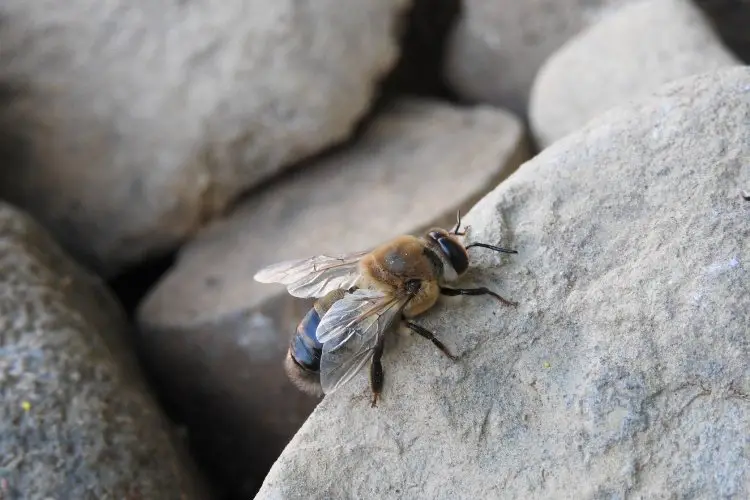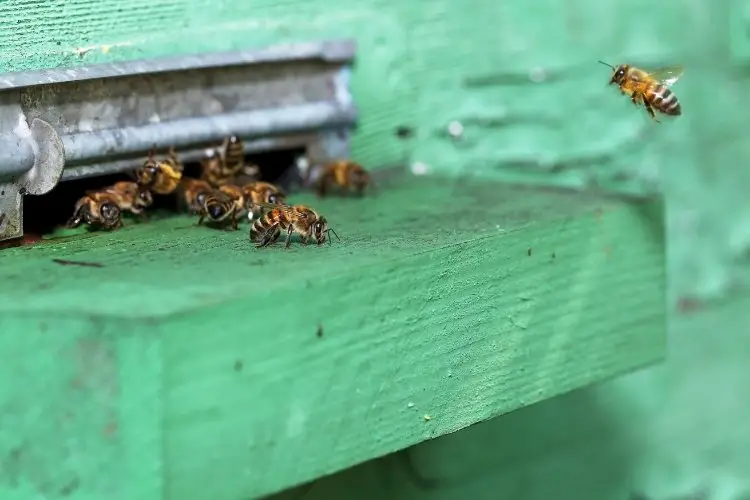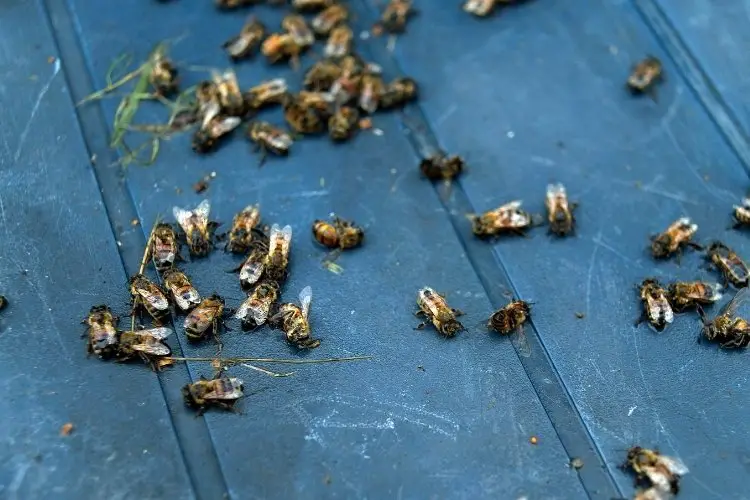When looking around your hive you might be surprised to see that there are a large number of dead bees on the ground just outside your hive entrance. When you take a closer look, you see they are the larger male bees, or drones. (If you’re not sure how to tell the difference between drones and workers, check out this post).
You’re probably wondering if such a thing is normal – or does it indicate there’s something wrong with your hive because you’ve never noticed so many dead bees outside the hive before. And why are there only drones and not worker bees?
Let’s find out possible reasons why there are so many dead drones outside the hive and if this is a normal event or not.
What Do Drones Do Inside The Hive?
Drones are the male bees you’ll find in a hive. They are easily recognized because they have larger eyes and a shorter, more rounded abdomen. They are larger than the female worker bees but not as large as a mature queen.
Usually a colony will consist of around 95% worker bees, one queen and approximately a thousand drones. A capped drone cell is easily recognized because it sticks up more prominently than a capped worker cell. Drones live approximately six weeks after emerging from their cells and are found in the hive usually during the Spring and Summer months.
The only known role of the drone is to mate with queens from other colonies, however there is more research being done to find out if the drone has other jobs within the hive.

In Spring and Summer, drones leave the hive to fly to a nearby area to mate with a queen. The area they (and the queens) fly to is known as a drone congregation area. These areas are spaced approximately two kilometers (1.2 miles) apart and are chosen because of the visibility of landmarks such as a large tree or open spaces.
Unfortunately for the drone, when he finishes mating with the queen, he sustains life ending injuries, so he falls to the ground and dies.
Why Are Drones Kicked Out Of The Hive In Winter?
Drones are kicked out of the hive during Winter because they don’t really have any other role in keeping the colony alive apart from, as we’ve said before, mating with a queen from another hive.
A drone can’t help feed the colony because it doesn’t have an elongated tongue or proboscis with which to suck nectar from flowers. Because of its almost hairless legs, it can’t gather pollen, and relies upon the worker bees to feed it. A drone can’t help defend the colony from attack either because it has no sting.
It’s no surprise then that drones are driven out of the hive by the workers as Winter approaches. This is because precious pollen and honey stores must be preserved to feed the colony during the colder months when foraging isn’t possible.

Drones in the hive just mean there are too many mouths to feed. As their only known function is to mate with a queen, more drones can be raised the following Spring when they’re needed for mating.
So when you see a large number of drones outside the hive in the Fall (Autumn) or early Winter, don’t be alarmed. It’s almost certainly a natural occurrence. Workers are preparing the hive for Winter. They need to keep all the stored honey and pollen they can to keep the colony alive during the cold months.
Dead Drones On The Ground During Other Times Of The Year
You may find large numbers of dead drones outside the hive during other times of year as well. This may occur if there has been a prolonged spell of wet weather in Spring or Summer that doesn’t allow the workers to get out and forage and drones to mate.
Drones will be seen as competition for precious stored food resources, so when they try to re-enter the hive, workers will keep them out. The drones, unable to get fed, starve to death outside the hive.
Also, the workers may decide not to feed the drones in the hive. As a result, they starve and fall to the bottom, where the workers will clean them out of the hive.

In addition to these measures, the workers may also remove the drone larvae from their cells and eat them as a protein source, or toss them out of the hive.
A period of very hot weather may result in a large number of drones being kicked out of the hive too. In the hot weather, bees congregate on the front of the hive in a behavior known as bearding.
Bees bearding outside helps keep the interior of the hive cool. As drones are just a drain on the colony’s resources by eating honey and taking up space, they are driven out of the hive and left to starve.
Final Thoughts…
If you notice a lot of dead drones outside your hive, then usually it’s a natural occurrence and is probably nothing to worry about.
Because drones aren’t able to feed themselves or help in hive defense, if the colony perceives a situation where food resources are under threat, drones are often seen as a burden and removed from the hive.
If there are so many dead drones blocking the hive entrance, you might help them open it up by using a stick or hive tool to remove some.
In addition, if you are concerned that there are dead drones outside the hive, you should talk with an experienced beekeeper in your area and find out if they’ve seen the same thing.
